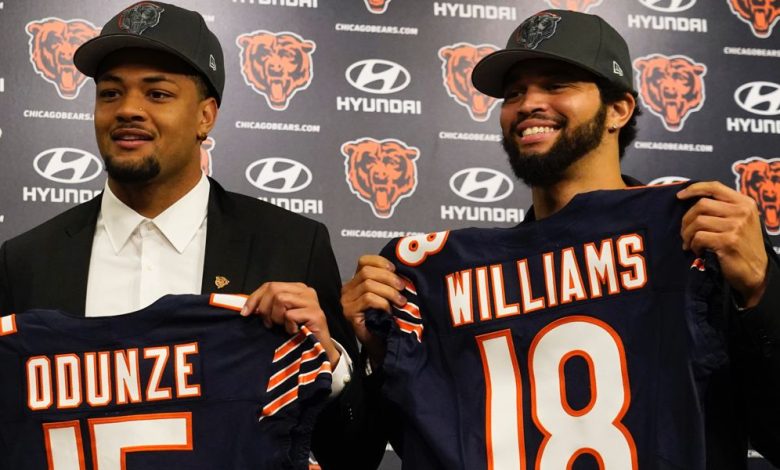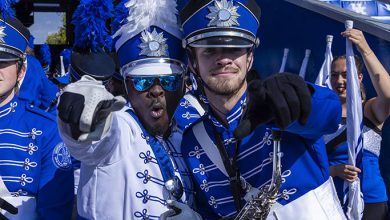Here’s How and Why the Chicago Bears Are Leading the AI Revolution in NFL Play Calls

In the rapidly evolving landscape of the NFL, technology continues to change the way teams approach every facet of the game. Whether it’s player health and safety, performance analysis, or even fan engagement, teams are utilizing cutting-edge tools to gain a competitive edge. One area where technological advancements have begun to make a notable impact is in play-calling, a fundamental aspect of football that dictates the flow and success of the game. The Chicago Bears, long known for their physical style of play and hard-hitting defense, are now emerging as leaders in an entirely different realm: the use of artificial intelligence (AI) in play calling.
While AI is not yet widely integrated across the league in play-calling, the Bears are ahead of the curve, employing advanced analytics and AI-driven technology to craft smarter, more efficient strategies on both sides of the ball. This shift towards data-driven play-calling is revolutionizing the way the Bears approach game planning, decision-making, and player utilization. But how exactly are the Bears using AI, and why are they at the forefront of this new age of football?
In this article, we’ll explore how the Chicago Bears have embraced AI to enhance their play-calling process, why it’s transforming the game, and how this innovation could reshape the NFL landscape in the years to come.
The AI Revolution: A Brief Overview
Before diving into the specifics of how the Bears are leading the charge, it’s essential to understand the role of AI in modern sports. At its core, AI refers to the use of machine learning algorithms and data analytics to process vast amounts of information, uncover patterns, and make predictions. In the NFL, AI can analyze player performance, team tendencies, opponent strategies, and other data points to generate insights that can improve decision-making.
For example, AI systems can process data from previous games to predict how an opposing defense might respond to a certain offensive scheme. They can identify mismatches in player abilities or even predict fatigue levels based on a player’s workload. AI can also optimize play calling by suggesting plays that maximize the chances of success based on factors like down-and-distance, field position, and opposing defensive alignment.
The Bears’ Shift Toward AI-Driven Play Calling
While the Bears have always had a reputation for their defensive prowess, they are increasingly becoming known for their use of technology in shaping their offensive and defensive schemes. In recent years, the team has made substantial investments in AI and analytics, incorporating machine learning models to assist in play-calling decisions. Head coach Matt Eberflus, who took over in 2022, has embraced a forward-thinking approach to both coaching and team management, prioritizing data-driven strategies to optimize performance on the field.
The team began implementing AI-driven play-calling processes during the 2023 season, initially using it for data analysis and player performance tracking. However, in 2024, the Bears expanded the role of AI within their play-calling operation, allowing it to play a more direct role in suggesting optimal plays during games.
Here’s how the Bears are utilizing AI in their play-calling and decision-making processes:
1. AI-Powered Play Prediction and Game Management
One of the most significant ways in which the Bears are leveraging AI is through the use of play prediction models. These models take in historical data, including previous game film, and utilize machine learning algorithms to predict how opposing defenses will respond to certain offensive formations and play designs.
By analyzing these patterns, the AI system suggests plays that are statistically more likely to succeed based on the opposing defense’s tendencies. For instance, if the Bears are facing a defense that historically struggles against outside zone runs or has a high rate of blitzing on third-and-long situations, the AI system will recommend plays that exploit those weaknesses. This predictive capability allows the Bears’ coaching staff to make more informed decisions, reducing the guesswork traditionally associated with play calling.
In addition, AI models can help the team manage in-game adjustments. For example, if the opposing defense shifts strategies mid-game—perhaps due to a change in personnel or injury—AI can quickly analyze the new alignment and suggest countermeasures on the fly. This adaptability is crucial in the fast-paced nature of the NFL, where games are often decided by a series of small, tactical adjustments.
2. Real-Time Data for Play Calling on the Sideline
One of the most revolutionary aspects of AI-powered play calling is the ability to access real-time data during games. While many teams have used analytics and statistics in post-game analysis, the Bears are among the first to incorporate live data analysis into their sideline operations. AI systems can now process in-game data—such as player positioning, defensive alignment, and even player fatigue—and provide coaches with instant insights to help guide play calls.
For example, if the Bears’ offense is struggling to gain yardage on the ground, the AI system might recommend shifting to a pass-heavy attack or utilizing specific play-action concepts that have been historically successful against the opposing defense. Likewise, if a key defensive player is off the field due to injury, AI can help identify the optimal time to attack the defense’s vulnerable areas.
This real-time analysis not only accelerates decision-making but also allows the Bears to maintain a high level of flexibility and creativity during games. It also gives the coaching staff the ability to make smarter, data-backed decisions without waiting for traditional film breakdowns or longer analysis periods.
3. Optimizing Personnel Utilization
AI also plays a critical role in helping the Bears optimize their personnel. In an era where player health and efficiency are top priorities, AI can analyze individual player performance data to identify which players are most suited for specific situations or matchups. For example, AI can suggest which running back should be on the field based on the opposing defense’s alignment, or which receiver is likely to exploit a specific coverage scheme.
Moreover, AI helps coaches and analysts predict when players may begin to show signs of fatigue, allowing for more efficient rotation during games. The Bears can monitor player workloads throughout the game and suggest substitutions at optimal moments to avoid overexertion, reducing the risk of injury and maximizing the impact of key players.
AI can also assist in identifying emerging talent. By tracking performance metrics such as speed, agility, and on-field decision-making, the Bears can make better-informed decisions regarding which players to prioritize in training and game situations.
4. Improving Defensive Play Calling Through AI
While much of the conversation around AI and play calling tends to focus on offensive strategies, the Bears are also employing AI to enhance their defensive schemes. Defensive coordinator Alan Williams and his staff are utilizing machine learning models to analyze the tendencies of opposing quarterbacks, running backs, and offensive lines. By studying how opposing offenses behave in various down-and-distance situations, the Bears’ defense can better anticipate plays and be more proactive in their response.
The AI system also assists in identifying potential mismatches during games. For example, if an opposing quarterback has a tendency to favor short, quick passes on third-and-medium situations, the AI can recommend defensive alignments and coverage schemes designed to shut down that particular route concept. Additionally, AI is used to identify weaknesses in offensive line protection schemes, helping the Bears’ pass rushers capitalize on vulnerabilities.
5. Collaboration with Tech Companies and Startups
The Bears’ commitment to leveraging AI and analytics has led to strategic partnerships with several cutting-edge technology companies and startups. The team works closely with data analytics firms, sports tech companies, and even AI research organizations to ensure they remain on the leading edge of innovation. These partnerships help the Bears stay ahead of competitors by providing access to the latest tools, resources, and insights available.
By collaborating with these companies, the Bears are not only gaining a competitive advantage on the field but also positioning themselves as leaders in the tech-savvy, data-driven approach to football. As more teams begin to recognize the value of AI in play calling, the Bears’ early adoption will likely serve as a blueprint for others to follow.
Why the Bears Are Leading the AI Revolution
The reason the Chicago Bears are leading the AI revolution in play calling can be attributed to several key factors:
- Forward-Thinking Leadership: Head coach Matt Eberflus and his staff have embraced the future of football. Rather than relying solely on traditional methods of coaching and play calling, they have opened the door to innovative technologies that can enhance their team’s performance.
- A Culture of Innovation: The Bears have a history of being forward-thinking, from their early use of the “46 Defense” to their adoption of advanced training techniques. Their willingness to embrace AI is simply another step in this ongoing culture of innovation.
- Data-Driven Philosophy: The Bears’ front office and coaching staff are firmly committed to making decisions based on data and analytics. This philosophy extends beyond just play calling—it influences player acquisition, training methods, and game strategy.
- Investment in Technology: The Bears have made significant investments in technology and AI to ensure they are staying ahead of the curve. By collaborating with tech startups and AI companies, they are securing cutting-edge tools that many other teams are just beginning to explore.
The Future of AI in NFL Play Calling
As the Bears continue to refine and enhance their AI-driven play-calling systems, it’s likely that more NFL teams will follow suit. The success of the Bears’ model could prompt other teams to invest in similar technologies, potentially leading to a league-wide transformation in how play calling is approached.
AI is not just the future of play calling—it’s the future of football strategy. By blending data, machine learning, and real-time analysis, the Bears are setting the stage for a more intelligent, efficient, and dynamic approach to the game. As other teams catch up, we could see a shift in the entire NFL landscape, with AI playing an increasingly pivotal role in shaping the outcome of games.
The 2025 season and beyond could very well be defined by teams using AI to make smarter, data-backed decisions, and the Chicago Bears will undoubtedly be at the forefront of that revolution.









